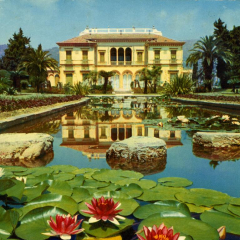The gardens of Château de Boulogne
In 1817 James de Rothschild bought the late 18th-century château de Boulogne from another banker, Jean-Charles Davilliers. Situated well beyond Passy at the edge of the Bois de Boulogne with the Seine running parallel to the estate, it provided the ideal summer retreat while still allowing easy access to Paris. In 1855 the architect Joseph-Armand Berthelin was commissioned to rebuild the house, creating a château in the style of Louis-Philippe. The Château stood in the middle of a park of one hundred hectares, ornamented with magnificent trees, French gardens, a splendid rose garden and a unique pergola covered with wisteria.
The château passed to James' youngest son, Edmond, who added his own alterations, commissioning Germain Debré to draw up the plans. After Edmond's death, his daughter, Alexandrine lived there until war broke out, after which the house fell into disuse and the garden was given to the town.
Île de France, Cap Ferrat
‘I have achieved my purpose by defying the laws of Nature and common-sense.’ Thus Baroness Béatrice Ephrussi, neé de Rothschild, (1864-1934) described her completed villa ‘Île de France’ and its gardens situated on the narrowest isthmus of the Cap Ferrat.
Béatrice had purchased 17 acres of land in 1905 and it was to take 7 years, 14 architects and hundreds of engineers and workmen before her dream was realised. The design of Villa Ile de France is officially attributed to Aaron Messiah, although many hold that it was the Baroness herself who was the real designer of the pink villa inspired by Italian palazzi and medieval colonnades. There exist several gardens within gardens, including Spanish, French, Rock, Exotic Plant and Italian gardens. These were created by the landscape architect, Achille Duchêne. From her loggia the Baroness would oversee her 30 gardeners at work bedecked in berets with red pom poms.
When Béatrice died in 1934, she left the house complete with contents and gardens to the Académie des Beaux-Arts. Villa et Jardins Ephrussi de Rothschild are open to the public.
Villa Victoria, Grasse
Alice de Rothschild (1847-1922) began to spend winters on the Riviera in 1887. Finding the coast vulgar, she purchased 100 hectares of land among the perfume fields of Grasse and began to build a house and possibly one of the most ostentatious and extravagant gardens ever seen.
The terraced hillside was landscaped into rolling parkland, where Alice planted citrus trees by the hundred, arranged in groups to make them appear more natural and integrate with the existing landscape.
There was a rock garden, a winter-flowering grotto and a spectacular 3 kilometre drive designed with hairpin bends; around every corner lay a surprise for the visitor as the planting became progressively wilder and the panorama extended itself further the higher one climbed.
Alice employed over 100 gardeners, dressed in the Rothschild colours of blue and yellow, to maintain her garden. Each year they planted 55,000 daisies, 25,000 pansies, 10,000 wallflowers, 5,000 forget-me-nots and 23,000 bulbs of tulips and narcissi.





















